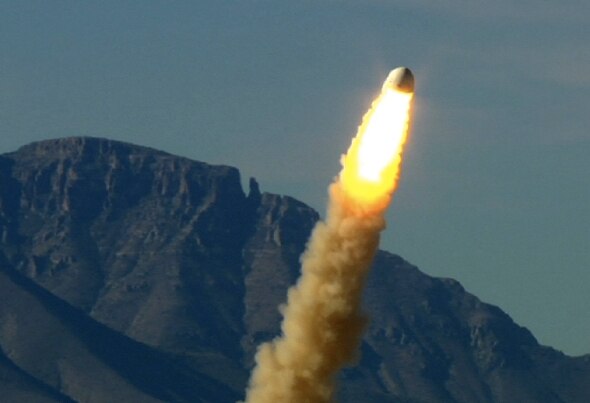Create a free profile to get unlimited access to exclusive videos, sweepstakes, and more!
Blue Origin Will Test Its Capsule Abort System ... in Flight!

Come October, the private space company Blue Origin will put on quite a show.
The company has already flown its New Shepard rocket four times into space—above the arbitrary but common-sense 100 kilometer height above Earth’s surface—and landed it successfully on its tail. It also have tested the crew capsule on top, deploying it more than once, including the last time when one parachute of three was purposely not used, to see how the capsule would do with only two (it landed just fine).
But the fifth flight of the rocket will be very different. To get certified by NASA for crewed flight, Blue Origin has to show that the crew capsule can escape rapidly on its own if the rocket below suffers a catastrophe (even if it only goes with private customers, Blue Origin still needs to prove it can do this). On the old Saturn V Apollo missions, this was done using a rocket mounted on a tower above the capsule (the so-called tractor or puller method). That added a lot of weight, and if it wasn’t used (it never was), it was ejected and thrown away after launch. That’s a waste of fuel and a perfectly good rocket.
Blue Origin has engines mounted below the capsule, which can be used to push the capsule away from the rocket in case of emergency. They tested this system dramatically in 2012, but it hasn’t been tested in flight, which is critical. And that brings us to the fifth flight of New Shepard: On that flight, scheduled for October of this year, the capsule will use the abort rocket to propel itself away from the main rocket during the ascent, which is when a catastrophe is most likely to happen. Not only that, but the company plans on doing this when the rocket is undergoing the maximum pressure from atmospheric passage during the flight, when the rocket will be moving faster than the speed of sound.
I guess that if you’re going to test a system, test it hard.
Here’s an animation of what this might look like:
The capsule will roar away from the rocket rapidly, and then (hopefully) parachute back safely to Earth. The rocket itself will not be as stable without the capsule on top, and will get a helluva kick as the capsule roars off. It may very well break up under the stress. Even it it survives the initial trauma, it’ll likely fall the rest of the way to the desert floor and impact at high speed. It’ll still have quite a bit of fuel on board, so, as CEO Jeff Bezos notes in an email, “…its impact with the desert floor will be most impressive.”
Most impressive. But if it does survive and lands, Bezos says it’ll be placed into a museum, which is fitting. It’s the first rocket ever to go into space and then land again vertically, let alone do it again three more times. It’s quite an accomplishment.
I’m interested in the fact that Bezos made this announcement at all; it was only a couple of years ago that everything the company did was kept secret until after it was accomplished. It seems that the string of successes has made Bezos (deservedly) more confident about Blue Origin’s ability to get things done.
I also have to wonder if SpaceX getting so much publicity is behind this as well. Elon Musk’s company has been sending cargo to orbit for some time, and has made huge strides in being able to reuse a vehicle. The loss of a Falcon 9 on the pad during fueling in early September was a major setback, of course, and will no doubt delay the first launch of a previously flown booster, which was set for later this year. It’s not clear when that will happen now.
Still, Bezos suddenly announcing events beforehand is interesting. They’ll even hold a live webcast of the launch when it occurs. I’ll have more information when we get closer to the time of launch. Stay tuned.


























